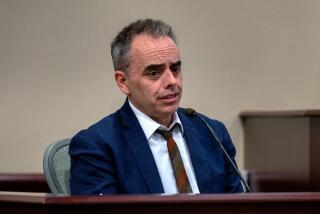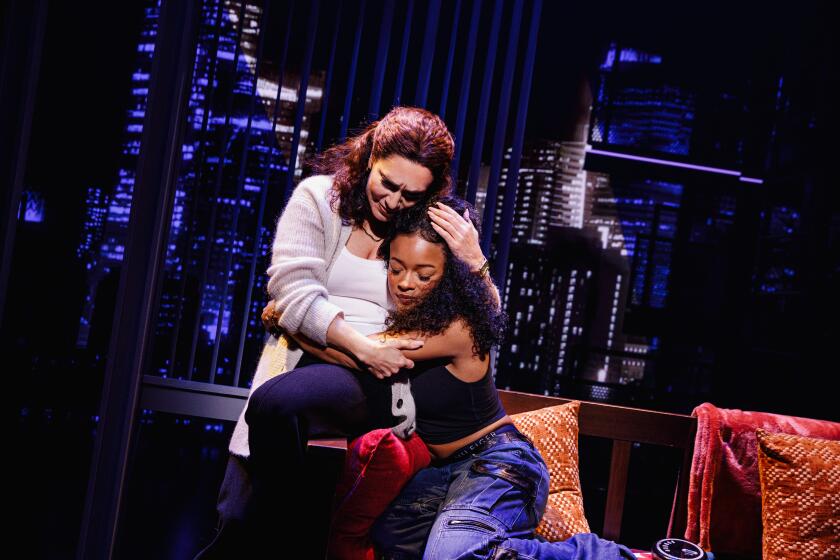Augustin Hadelich is prepared this time for his Hollywood Bowl concert
Classical musicians never really know what’s coming around the next bend in the road. You might be sitting around in your home or apartment, practicing, reading, loafing, whatever, and then the phone rings. It’s your manager, and he puts it to you indirectly at first. “How’s your Prokofiev Second doing?”
That’s how Augustin Hadelich, a rising star in the violin world, found out that he was going to make his Los Angeles Philharmonic debut at fabled Hollywood Bowl two summers ago this month. Fellow violinist Julian Rachlin had canceled his appearance in the Prokofiev Second Violin Concerto due to illness on less than a week’s notice. Not only that, the scheduled conductor on the program, Edo de Waart, had just canceled his appearance due to illness, and Miguel Harth-Bedoya was rushed in.
“It was sort of a shock,” Hadelich, now 26, said in accented English by phone from his home in New York’s Upper West Side about a block from Lincoln Center.
But then, like an unexpected pop quiz in high school, maybe it’s better that way. “Sometimes in my experience,” Hadelich added, “it’s better for something to happen suddenly instead of waiting years or months for a concert or engagements, so you don’t have any time to worry about it.
“Of course you can only do it if you are comfortable playing it, depending on what piece it is, or when you played it last. It’s a very hard decision to make, but sometimes if it has been years and you think it needs more work, then it’s very important to have the courage to say no. No one feels badly if you don’t do it. I wasn’t 100% certain, but I decided to go for it.”
As things turned out, Hadelich — who returns to the Bowl Thursday, this time scheduled well in advance — turned the emergency Bowl call into a personal triumph. He had a firm grip of all aspects of the Prokofiev — the line, the rhythm, the piece’s lyrical and playful qualities — wrapped in a lovely, dark-shaded, unforced tone from his 1683 Stradivarius (he has since switched to another Strad, which he will play for the first time in concert at the Bowl). His encore, Paganini’s supremely difficult Caprice No. 21, was also impressive — intonation dead-on, with a luscious tone and an Old World grace that you don’t hear very much from young violinists anymore.
And would you believe lightning struck for him again, for Hadelich just made his New York Philharmonic debut at the Bravo! Vail Valley Music Festival in Colorado July 24, subbing for Nikolaj Znaider in the Mendelssohn concerto. “In that case, I had about three days notice,” he said. “I was actually at the airport and was going to fly to Italy for a vacation for a week. I got the call at the airport and took a cab back home. Since I was working on that concerto anyway [he’ll be playing the Mendelssohn at the Bowl], there was not much hesitation.”
Putting it all in perspective, though, these last-minute calls with major orchestras may seem like nothing when compared to the ordeal Hadelich went through as a teenager to rebuild his career.
Born in the Tuscany region of Italy to German parents, Hadelich picked up the violin at age 5 because his brothers were playing piano and cello. Living in an area isolated from the music world meant that Hadelich had to develop a lot of his talent on his own. But he did make frequent trips to Germany with his family and got noticed there, participating in Yehudi Menuhin’s master classes and even playing the Bruch concerto under the aged Menuhin’s baton.
Hadelich seemed to be on his way, but at 15 he was badly burned throughout his upper body when some tractor fuel caught fire at the family farm in Tuscany. He was hospitalized for many months, and some thought that he would never play again, although Hadelich says that no doctor told him that in so many words. A similar accident befell the great Belgian Gypsy jazz guitarist Django Reinhardt as a teenager when his caravan caught fire. But unlike Django, who had to learn to play again with only three working fingers on his left hand, Hadelich fortunately regained sufficient mobility.
What took longer to heal was his motivation to resume his life as a musician. “After awhile, it was hard to deal with a setback,” he said. “The funny thing is when I started to feel more comfortable with it, other people started feeling more comfortable with me.”
Hadelich has shown other signs of being a most unusual violinist. He takes the trouble to write his own cadenzas for some concertos, the scores of which he posts on his website augustin-hadelich.de. Rather than tackle the usual Romantic-period showpieces, his first recordings were of the Haydn concertos and Telemann solo fantasias. His latest album, “Flying Solo” on the Avie label, contains nothing but exposed difficult solo literature by Bartók, Paganini, Ysaÿe and Bernd Alois Zimmermann — a bird on a wire, indeed.
And he wants to champion even newer music — like the Adès, Schnittke, Adams and especially the Ligeti concertos. “What’s very important to me is to have a stylistic variety in my repertoire. “As long as I have that, I won’t get tired of any composer or style. It creates a balance that is very healthy for my psyche,” he said with a laugh. “And some of the violin concertos are such great pieces that you don’t get tired of them.”
Like the Mendelssohn concerto, he notes. “I love how incredibly concise it is. It is relatively short, but so much is packed into that short time. After awhile, it can become a drag to practice it, but the music itself I won’t get tired of. I feel only quite recently that I’ve started to really play the piece well.”
calendar@latimes.com
More to Read
The biggest entertainment stories
Get our big stories about Hollywood, film, television, music, arts, culture and more right in your inbox as soon as they publish.
You may occasionally receive promotional content from the Los Angeles Times.





